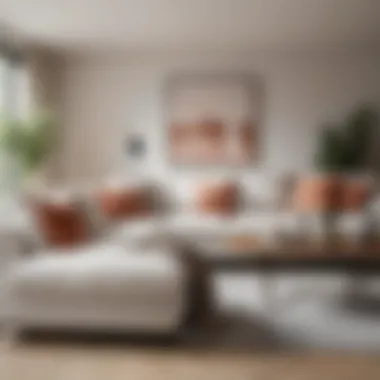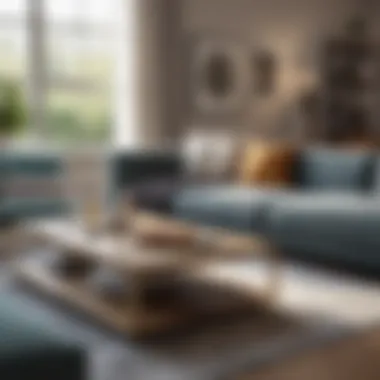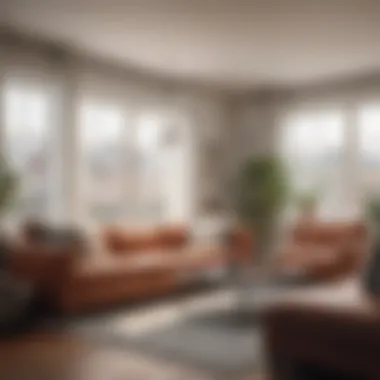A Detailed Guide to Sectional Sofas Without Chaise


Intro
Sectional sofas without a chaise offer a unique aesthetic and practical solution to contemporary living spaces. Unlike their chaise-equipped counterparts, these sofas embrace versatility, making them suitable for a variety of layouts and styles. Whether it's a cozy apartment or a spacious family room, understanding the nuances of these sectional sofas can greatly enhance the functionality of your space.
In this guide, we are diving into the heart of sectional sofas, exploring their captivating designs and practical benefits. We will shed light on design inspirations, practical tips, and current trends that will empower you to make informed choices. Let’s embark on this journey to create a beautifully furnished living area without missing a beat on comfort and style.
Design Inspiration
Trending Design Styles
When it comes to sectional sofas without a chaise, there are numerous design styles that are making waves. From sleek modern lines to nostalgic mid-century vibes, there's plenty to choose from.
- Modern Minimalism: Clean lines, neutral colors, and functional forms characterize this style. Sectionals in this genre often feature slender profiles that fit snugly against walls.
- Bohemian Charm: Multiple textures, patterns, and bold colors can bring life to a room. Look for sectionals that combine earthy tones with vibrant cushions, seamlessly blending comfort and style.
- Transitional Elegance: This style is the darling of homeowners who love both traditional and contemporary aesthetics. Sectionals that offer tapered legs and plush upholstery can truly stand out in a transitional setting.
It's crucial to select a style that synchronizes with your interior decor while catering to personal taste. Keep an eye out for popular brands like West Elm or Crate & Barrel, which are renowned for their stylish and functional furniture.
Color Palettes and Themes
Color plays a significant role in setting the mood of a living space. For sectional sofas without a chaise, it's wise to think outside the box.
- Monochromatic Schemes: Choosing a single color in various shades can create a sophisticated and calming environment, promoting coherence in your decor.
- Contrasting Accents: Incorporate contrasting hues through cushions or throws to inject personality into your space. A deep navy sectional, for instance, pairs beautifully with mustard or rust-colored accessories.
- Earthy Tones: With a growing emphasis on natural materials and organic color palettes, opting for warm browns, greens, and grays can bring a touch of the outdoors inside, aligning perfectly with a modern rustic theme.
"A well-chosen color can not only beautify but also energize or soothe a room, creating the perfect backdrop for relaxation and socializing."
Practical Tips
Space Optimization Techniques
Maximizing the utility of your living space is essential when selecting sectional sofas. Here are some tips:
- Measure Your Space: Take a tape measure and jot down dimensions before heading out shopping. Knowing how much room you have will prevent any sofa mishaps.
- Placement Strategy: Think of establishing zones. For example, an angled sofa can create a more inviting conversation area, while a straight layout can make a narrower room feel longer.
- Use Multi-Functional Pieces: Consider pairing your sectional with a coffee table that has storage or side tables that can be moved around easily.
DIY Furniture Projects
For those who love a touch of personal flair, DIY projects can breathe new life into a standard sectional. Here are some easy options:
- Reupholstering Cushions: Choose trendy fabrics to refresh worn-out cushions, instantly giving your sectional a makeover.
- Creating Built-in Features: If you’re handy, integrating shelves or tables along the back of your sectional can provide additional storage and style.
- Pillows and Throws: Crafting your own pillows from fabric scraps can bring a customized feel to your sofa while promoting sustainability.
Understanding Sectional Sofas
When delving into the vast world of furniture, particularly in the realm of living space designs, sectional sofas stand out as a subject worthy of exploration. Understanding sectional sofas is not just about recognizing their aesthetics, but also grasping their functionality, adaptability, and unique placements in homes. Knowing how these pieces fit into various styles and spaces guides homeowners, designers, and enthusiasts alike in making choices that complement their environment.
Sectional sofas offer a wonderful blend of comfort and style. They come in a myriad of configurations, which means they can be tailored to meet individual preferences and spatial constraints. This flexibility is particularly significant in today's diverse living environments where maximizing space is a key consideration.
Definition of Sectional Sofas
Sectional sofas, in their most straightforward definition, are sofas that consist of multiple pieces that can be arranged and rearranged to suit various layouts. Typically, they include two or more sections—often combined with a middle piece forming an L or U shape. Unlike traditional sofas that are linear, sectionals allow for a variety of seating arrangements, making them especially suitable for accommodating guests or simply lounging as a family.
Sectionals can feature a variety of components like recliners, ottomans, and chaise lounges, though this guide focuses specifically on those without a chaise. This allows for a more streamlined look, efficient use of available space, and versatile arrangements. The absence of a chaise may encourage a more open layout, which can seamlessly integrate into either small spaces or larger open concept areas.
Historical Context
The journey of sectional sofas began in the 19th century, reflecting broader trends in society and home decor. Originally, sofas were single pieces, but as families grew and social gatherings became a hallmark of domestic life, the need for more flexible seating arrangements emerged. The sectional sofa transformed the landscape of furniture design by facilitating a new way to think about living space.
During the mid-20th century, sectional sofas gained popularity, especially as homes began to open up with larger living areas, intertwining dining and entertaining spaces. Iconic designs like the Mid-Century Modern sectionals showcased sleek lines and a minimalistic approach that resonated with the tastes of the time.
Over the years, various movements, from the bohemian influx of the 1970s to the bold colors of the 1980s, shaped the evolution of sectional sofas. Today, they stand as a versatile choice, appealing to modern homeowners looking for both comfort and aesthetic appeal.
Understanding the definition and historical significance of sectional sofas gives valuable context for their role in contemporary design. It becomes evident that their influence reaches beyond mere utility; they help shape the very essence of how we define our living spaces.
The Chaise Debate
In the world of furniture, the discussion around sectional sofas often circles back to the presence or absence of a chaise. This debate holds significant weight for homeowners and designers aiming to create a functional yet stylish living space. Choosing a non-chaise sectional might seem like a lesser option at first glance, but understanding its benefits can truly elevate your design choices.
What is a Chaise Lounge?
A chaise lounge, or a chaise for short, is a piece of furniture that combines the capabilities of a sofa and a lounge chair, allowing one to sit comfortably or stretch out. Picture it as a luxurious solo chair with long legs, just waiting for someone to kick back and unwind. It often features an extended seat, providing ample space to recline. From classic French origins to modern iterations, chaisses have adorned living rooms and sunrooms across the globe. However, they also take up valuable floor space, which leads us to ponder:
- Is a chaise essential for relaxation?
- Can a sofa without one still offer comfort?
- Do they sacrifice utility for style?
Time to explore why many are moving away from this traditional setup.
Benefits of Choosing Non-Chaise Sectionals
Opting for a non-chaise sectional embodies a unique blend of practicality and aesthetic appeal. Here’s why many are making this decision:
- Space Efficiency: Non-chaise sectionals are often more adaptable to different room sizes. They can better fit snug corners and even offer a linear layout that saves space while still providing generous seating.
- Versatile Arrangements: A sectional without a chaise provides freedom in furniture arrangement. Homeowners can easily shift pieces around, catering to any occasion or rearranging for fresh vibes.
- Aesthetic Variation: The diverse styles of non-chaise sectionals allow them to fit seamlessly into various design themes, from modern minimalism to classic traditional. This flexibility gives room for creativity.
- Easier Maintenance: Fewer nooks and crannies mean cleaning is less of a hassle. With a straightforward design, you can focus more on enjoying the sofa rather than fussing over its upkeep.
Ultimately, the choice of a non-chaise sectional fosters an environment that values freedom of arrangement and an inviting glow of comfort without the burden of extra furniture in the way.
"A sectional without a chaise opens doors to endless layout possibilities, altering not just a living space but also how one interacts with it."
The considerations surrounding chaise lounges versus non-chaise sectionals demonstrate that sometimes simplicity can lead to unexpected sophistication.
Now that we've navigated the chainges, let’s dive into the design attributes that make non-chaise sectionals worthy contenders in home design.
Design Aspects of Non-Chaise Sectional Sofas


Understanding the design aspects of non-chaise sectional sofas is paramount for anyone looking to effectively utilize their living space. These sofas can be a reflection of personal style, comfort preferences, and practical needs. Unlike their chaise counterparts, non-chaise sectionals maximize the available seating while often offering versatility in arrangement. When opting for these designs, several key elements can significantly impact not only the aesthetics but also the functionality of your space.
Style Variations
The beauty of non-chaise sectional sofas lies in their ability to harmonize with various design styles. Let’s break them down further.
Modern
Modern sectional sofas are know for their clean lines and minimalistic approach. This style often incorporates bold colors and geometric shapes, contributing a sense of sophistication to any setting. A key characteristic of modern designs is their emphasis on functionality without sacrificing aesthetics. This is a beneficial choice for homeowners who prefer sleek, uncluttered spaces.
One unique feature of modern sectionals is their modularity. Many consumers appreciate the ability to rearrange seating configurations, adapting to different occasions or moods. However, some might find that modern sofas can lack the warmth often associated with more classic styles, potentially making a living space feel a bit too stark or cold.
Traditional
On the other hand, traditional sectional sofas exude classic elegance and timeless appeal. This style typically features ornate details such as rich fabrics, intricate woodwork, and curvaceous lines. Homeowners may find traditional sectionals appealing for their ability to create a cozy, inviting environment that feels familiar and comforting.
A unique feature of traditional designs is the richness of their materials, often using luxurious textiles that enhance their tactile experience. However, they can sometimes be bulky, which might not suit smaller spaces or modern minimalist themes.
Contemporary
Contemporary sectional sofas blend current trends with thoughtful designs. They tend to be versatile, incorporating features from both modern and traditional styles. A hallmark of contemporary design is the use of updated materials — think eco-friendly fabrics or sustainably sourced woods. This style allows homeowners to create a space that feels both trendy and responsible, engaging those with a keen environmental consciousness.
Unique to contemporary sectionals is their emphasis on comfort, often providing deeper seating and plush cushions. Yet, because this style is ever-evolving, what’s considered contemporary today might look outdated in a few years.
Size and Space Considerations
When choosing a non-chaise sectional sofa, size and space considerations cannot be overlooked. It's crucial to measure your living area accurately and understand the scale of the sectional in relation to other furniture. A larger sectional may dwarf a cozy room, while a smaller one may feel swallowed in a spacious layout.
Here are some points to consider:
- Room dimensions: Measure your room for length and width, allowing for other furnishings and walking paths.
- Seating needs: Assess how many people usually sit and if you entertain often.
- Proportional design: Ensure that the style of the sectional complements the proportions of your room.
- Versatility of arrangement: Modular designs provide flexibility and can be a game changer in optimizing space usage.
Designing your living space with a keen eye on sectional sofa elements is key to achieving a harmonious balance. Remember the right choice reflects both your style and the dynamics of your living area.
"Furniture should be a reflection of personal taste, not just practicality."
Balancing aesthetic desires with functional choices transforms your home into a sanctuary that feels just right.
Materials and Finishes
When it comes to sectional sofas without a chaise, selecting the right materials and finishes is paramount. This decision heavily influences both aesthetics and functionality, altering how the sofa complements a space and how it stands up to daily use. In addition to style, understanding the nuances of various materials can help consumers make informed choices that blend appealing looks with the necessary durability.
Fabric Choices
Leather
Leather is often hailed for its classic appeal and lasting durability. One standout characteristic of leather is its ability to age beautifully over time. As the leather develops a natural patina, it becomes a unique piece that tells a story. This quality makes leather a popular choice among homeowners who desire rich texture and a touch of luxury in their living spaces.
However, leather does come with its own set of pros and cons. On one hand, it's fairly easy to clean and maintain, making it practical for busy families or pet owners. On the other hand, it can be a bit pricey upfront and may require special conditioning treatments to prevent cracking or fading, especially in sunny areas. Overall, its sophisticated allure often outweighs potential downsides.
Microfiber
Microfiber has gained traction in recent years due to its soft feel and affordability. It’s known for its stain-resistant properties, making it an excellent option for households with young children or pets. Another key feature is its versatility—microfiber easily mimics the look and texture of more expensive fabrics without breaking the bank.
On the flip side, some may find microfiber less breathable than natural fabrics, which can lead to discomfort in warmer climates. Additionally, while it offers ease of cleaning, frequent maintenance is necessary to keep it looking pristine, as it can attract dust and pet hair more readily than other materials.
Blends
Blended fabrics represent a sweet spot between the premium feel of natural fibers and the practicality of synthetics. Common blends include cotton-polyester mixes, which provide softness while adding durability. This versatility in blends appeals to those looking for a cost-effective solution without sacrificing comfort.
However, blending materials can sometimes lead to inconsistency in texture and feel, depending on the ratio. Consumers might also find it more challenging to care for blends, especially compared to pure fabrics.
Frame Construction
The frame of a sectional sofa is as crucial as the materials covering it. The integrity and durability of the sofa depend largely on the type of frame used.
Wood
Wood has long been a stalwart in furniture design owing to its natural strength and aesthetic versatility. A frame constructed from solid hardwood is typically stable and durable, withstanding the wear and tear of daily use. Furthermore, wood comes in a variety of finishes—allowing it to fit seamlessly into diverse interior styles.
Nevertheless, it's worth noting that not all wood is created equal. Plywood or particleboard may be lighter and cheaper, but they typically don’t have the same robustness as solid wood. This raises questions about long-term investment in furniture, particularly for sectional sofas intended as centerpiece pieces.
Metal
Metal frames have begun to carve out their niche in the furniture world, often appreciated for their contemporary appeal and sleek lines. They provide a modern aesthetic while boasting remarkable strength. A metal sofa frame can be lighter than its wooden counterpart, making it easier to rearrange.
That said, metal frames might not offer the warmth that wood does, and they can be prone to rust if not properly treated. Additionally, noise can be an issue; certain metal components may creak or squeak over time, which could detract from the overall comfort.
Engineered Wood
Engineered wood, the blend of wood fibers broken down and recombined, presents a more cost-effective solution. It can mimic solid wood in appearance, while being more stable and less dependent on the moisture levels of its environment. Generally, engineered wood is eco-friendly, utilizing materials efficiently and allowing for reduced waste in production.
However, buyers should be cautious. Although engineered wood can be durable, its longevity often depends on the quality of construction. Cheaper versions might warp or deteriorate over time, leading to frustration in the long-term ownership of the furniture. In contrast to solid wood, they might not exude the same timeless elegance.
"Choosing materials and finishes is not just about looks; it's about making decisions that resonate with your lifestyle. "
In summary, the materials and finishes chosen for sectional sofas without a chaise play a pivotal role in enhancing both form and function. Understanding different options, from fabrics to frames, ensures that consumers select pieces that uphold their aesthetic visions without compromising on practical needs.
Functionality and Comfort


When picking a sectional sofa, functionality and comfort can’t be overlooked. These two aspects not only determine how much use your sofa will see but also how enjoyable that use will be. Balancing style with utility matters, especially in a piece that acts as the centerpiece of your living space. It’s quite clear that these sofas have a dual role; they should cater to aesthetic preferences while serving practical needs, all without sacrificing comfort.
Seating Capacity and Arrangements
Seating capacity is a crucial consideration when deliberating on a non-chaise sectional. This factor essentially defines how many folks can kick back and enjoy the space comfortably. A good sectional can accommodate a family during movie night or host friends during the game.
Here’s where layout plays a vital role:
- Corner Sectionals: Ideal for maximizing seating while blending into the corners of a room. Perfect if you have a smaller living area.
- L-Shaped Layouts: Offers flexibility in arrangements. You can place one side against the wall, opening up space for a coffee table in front.
- U-Shaped Options: If you’re the social butterfly, these allow for ample seating, creating a welcoming area for gatherings.
Considering how many people typically occupy your living space will influence your buying decision. Having the right seating arrangement can transform how individuals interact within the space and promote a cozy, inviting atmosphere.
Cushion Types and Firmness
Cushions contribute significantly to both the comfort and aesthetic appeal of a sectional sofa. Not all cushions are created equal. The type and firmness of the cushions can alter the entire sitting experience. Here are some common types:
- Foam Cushions: Dense and firm, but can lose shape over time.
- Down and Feather Blends: Luxurious and plush, these offer a soft feel but require regular fluffing to maintain shape.
- Memory Foam: Offers both comfort and support. It's a good choice for those who want to sink into the sofa after a long day.
Firmness is another tale to tell. Softer cushions can seem inviting, yet they may not provide necessary support, leading to discomfort during long sit-downs. Conversely, overly firm cushions might not promote the relaxation that most seek in a sofa. Finding the sweet spot matters as everyone has different preferences.
Ultimately, it’s about finding the right combo that matches your lifestyle and comfort needs. A quality sectional balances seat depth, firmness, and cushioning to ensure comfort that lasts.
To sum up, while the aesthetic representation of a sectional without a chaise is essential, the functionality and comfort elements are equally paramount. A well-considered choice will yield a sofa that's not just visually appealing but also a haven for relaxation and socializing.
Ideal Settings for Non-Chaise Sectionals
Choosing the right sectional sofa is essential when designing a living space. Non-chaise sectionals, in particular, can offer flexibility and style without the bulk of a chaise. The benefit of these sofas lies in their adaptability to various settings. Their design maximizes seating while maintaining an open aesthetic. This section examines two primary environments where non-chaise sectionals excel: small spaces and open living areas.
Small Spaces
In rooms where every square foot counts, non-chaise sectionals can be a game changer. Unlike traditional sofas with a chaise, which can dominate a room, these sectionals provide a streamlined look. They fit snugly against walls, allowing for more walking space and flow within a small layout.
- Maximizing Floor Space: These sectional sofas can nestle into corners or along walls without losing functionality. This is particularly beneficial in apartments or smaller homes where space constraints are a daily challenge.
- Versatile Arrangements: One of the standout features is how they can be rearranged easily. For example, you can switch the sofa's orientation based on your gathering needs.
"A non-chaise sectional transforms how a room feels, creating a cozy nook without overwhelming the space."
Opting for models with built-in storage solutions or multifunctional components can also enhance their utility in these small areas. With features like pull-out beds or compartments hidden within the seats, functionality reigns without compromising on style.
Open Living Areas
Non-chaise sectionals are also ideal for open living spaces. In these environments, maintaining an inviting and cohesive design is crucial. Here, sectionals can serve as a divider, defining spaces without barriers. They blend functionality with aesthetics, creating a defined social zone while keeping the area feeling airy.
- Seamless Flow: The open layout allows for natural movement among spaces. A sectional can function to delineate seating without blocking the view or airflow.
- Decorative Element: A well-chosen sectional can be a focal point. The design can draw the eye and set the tone for the area. For instance, a plush fabric or standout color can provide a stunning contrast against neutral walls.
- Social Interaction: Arranging sectional sofas in an L-shape or U-shape naturally encourages conversation. This setup invites people to gather around a central coffee table, making it an excellent choice for families or entertaining guests.
Trends in Sectional Sofa Design
Understanding trends in sectional sofa design is vital for homeowners, designers, and furniture enthusiasts looking to create stylish, functional living spaces. As preferences shift over time, knowing these trends can help you make informed choices—whether you’re selecting a new piece or redesigning a room. Embracing current styles allows one to harmonize aesthetics with practicality, ensuring that your soft furnishings blend effortlessly into the fabric of your daily life. In this section, we’ll explore two significant elements of these trends: color palettes and innovative features.
Color Palettes
When it comes to sectional sofa designs, color palettes play an essential role. The hues you choose can influence mood, perception of space, and even the overall style of your living area. Part of the charm of non-chaise sectionals is their ability to provide versatility with colors.
1. Trendy Tones: Neutrals like gray, beige, and taupe are timeless options. They offer flexibility and blend well with various decor styles. Nowadays, more daring colors are trending too. Bold jewel tones such as emerald green or navy blue can add a dramatic touch to your space.
2. Textural Variations: Avoiding monotony can be achieved by combining colors with differing textures. For instance, a soft velvet in a deep burgundy can contrast beautifully against a sleek leather piece in lighter shades. This interplay can add depth and interest, breaking up the visual space in a way that feels fresh.
3. Thematic Choices: Different color schemes can encapsulate specific themes. A coastal vibe might call for light blues and whites to convey airiness, while an industrial chic setting may thrive with grays and blacks intertwined with metal accents.
Here’s a quick recap of some popular color trends in sectional sofas:
- Soft earth tones for a calm environment.
- Vibrant jewel shades for standout pieces.
- Monochromatic schemes for modern minimalism.
Innovative Features
The rise of innovative features in sectional sofas showcases how furniture design has evolved beyond mere aesthetics. Functionality is a cornerstone in today’s market, appealing to a practical audience that values smart solutions.
1. Modular Designs: Many of today’s sectionals come with modular components, allowing for customized arrangements. This adaptability means that you can easily rearrange your setup to suit different occasions or optimize space in unconventional layouts.
2. Built-In Storage: Some sectionals now offer hidden storage compartments. This feature is particularly appealing for small spaces or for those keen on maintaining a clutter-free environment. You can store blankets, books, or even remotes, enhancing both functionality and neatness.
3. Technology Integration: In the age of smart homes, sectional sofas are evolving to accommodate technology. For example, USB charging ports and Bluetooth speakers can be seamlessly integrated into the design, making your sofa a functional hub rather than just a seating area.
4. Adjustable Components: An interesting trend is the inclusion of adjustable parts in sectionals—like reclining seats or extendable sections. Such features can cater to different seating needs without compromising on comfort or style.
"The future of sectional sofas is not just about what looks good—it's about enhancing living experiences, making them as practical as they are stylish."
Maintenance and Care
Maintaining and caring for your sectional sofa without a chaise is crucial for preserving its aesthetic appeal and functionality over time. This helps not only to extend the lifespan of the furniture but also to ensure that it continues to provide comfort and style in your living space. Having a proper maintenance routine can save you from future costs and keep your space looking polished.
An unkempt sofa can quickly become an eyesore, potentially ruining the ambiance of your entire room. Regular upkeep allows you to avoid discoloration, fabric wear, and other noticeable damage that often comes from neglect. One of the core considerations involves understanding the type of materials used in your sectional, as different materials may have unique cleaning needs. The investment in quality care translates to an inviting environment for both hosts and guests alike.
Cleaning Different Materials
Cleaning different materials requires a tailored approach, as what works for one type might not suit another. Some common materials you might encounter include leather, microfiber, and various fabric blends. Each has its own quirks and requirements.
- Leather: Clean using a damp cloth and a gentle leather cleaner. Avoid soaking the leather, as it can lead to deterioration. After cleaning, applying a conditioner can help maintain its luster.
- Microfiber: A simple vacuuming session usually does well to remove dust. For stains, a mixture of mild detergent and water applied gently can lift tough marks without damaging the material.
- Blended Fabrics: Depending on the blend, check care labels for specific instructions. Often, a mild soap, water, and a soft brush can work wonders. Test any cleaning solution in an inconspicuous area first to prevent unforeseen discoloration.


"An ounce of prevention is worth a pound of cure. Regular upkeep is far less burdensome than extensive repairs!"
Preventive Measures
Taking preventive measures is essential to keep your sectional in top-notch condition. A few tips can go a long way in safeguarding your investment.
- Regular Vacuuming: Use the upholstery attachment on your vacuum cleaner regularly. This will help to eliminate dirt and prevent buildup that can wear down fibers over time.
- Use Fabric Protection: Consider applying a fabric protector if your sofa is made of sensitive material. This can create a barrier against spills and stains.
- Position with Care: Be mindful of where your sofa sits. Avoid placing it in direct sunlight, as this could lead to fading.
- Rotate Cushions: If your sectional has removable cushions, rotate them periodically to ensure even wear and tear. This can prevent any one area from becoming too compacted or landing more stains than the others.
Budget Considerations
In the realm of furniture shopping, especially when it comes to sectional sofas without chaisses, understanding budget considerations is paramount. Making a purchase that aligns with your financial comfort is not merely an exercise in thriftiness; it's about striking a balance between aesthetics, functionality, and long-term investment. With the plethora of options on the market today, knowing how to navigate through price ranges while ensuring value for your money is essential.
A well-thought-out budget will enable you to explore an array of possibilities, limiting the risk of falling for impulse buys that may leave your wallet feeling a tad lighter and your living space lacking in character. Here, we will delve deeper into the specifics of pricing and the value you can expect from various sectional sofa options.
Price Ranges
When scouting for a non-chaise sectional, price can be a real eye-opener. You might stumble across a sofa labeled as a deal at a local retailer, only to find it doesn’t hold a candle to more expensive models in terms of durability or style. Prices can vary significantly based on material, size, and brand. Here’s a brief breakdown of what you might encounter:
- Budget-friendly options ($500 - $1,000): These are often made from synthetic materials or lighter woods. They may not have the longevity you hope for but can still serve a purpose in light-use environments.
- Mid-range products ($1,000 - $2,500): This price range typically includes better quality materials, such as sturdier frameworks and upholstery that withstands daily wear.
- Premium selections ($2,500 and up): Expect to see high-quality materials like genuine leather, handcrafted frames, and customizable styles. These can also come with warranties, giving you added peace of mind.
Determining where you stand in these categories can help focus your search. Remember, just because a sofa is expensive doesn’t mean it’s the right fit for you.
Value for Money
When navigating the world of furniture, assessing value for money isn't just about finding the lowest price. It’s about understanding the return on your investment. A sectional sofa can be a centerpiece of your living space, both in function and design. Here are some considerations as you evaluate value when making your purchase:
- Durability: Look beyond the surface. Often, sofas that cost a bit more are built to last, featuring reinforced seams and heavier frames.
- Functionality: A sectional should feel comfortable while meeting your lifestyle needs. For families or frequent entertainers, buying a sofa that stands the test of time through daily use is an important factor.
- Stylishness: A well-chosen sectional isn't just a piece of furniture; it's a focal point of your decor. If it aligns with your style and can adapt to changing aesthetics within your home, that adds value.
- Maintenance Costs: Consider the long-term upkeep. Sofas made with easy-to-clean fabrics might save you money in the future, especially if you have pets or young children.
To sum up, while the initial cost is a primary factor, assessing long-term value will give you a clear picture of what a good investment looks like.
"A wise buyer recognizes that a low price can hide high costs."
Purchasing Non-Chaise Sectionals
When it comes to selecting the right sectional sofa, the choice of a non-chaise variant carries unique advantages worth considering. Sectional sofas can shape the functionality and aesthetic of a living space, making the purchase decision pivotal. Opting for non-chaise sectionals opens up a realm of possibilities for design and layout while ensuring every inch of the room is used effectively. In a world where spaces are becoming increasingly compact, these sofas not only provide ample seating but also blend seamlessly into various environments.
The significance of understanding where and how to purchase this type of furniture transcends mere shopping. It involves recognizing the landscape of available options, from local stores to online marketplaces. Consumers should assess not just the quality and style of the sofas but also their own needs and how these options fit into their lifestyle and living areas.
Where to Buy
Navigation through the myriad of places to purchase non-chaise sectionals can be daunting. Here are some key avenues to explore:
- Furniture Stores: Retailers like IKEA, Ashley HomeStore, and Wayfair provide a range of choices in-store and online. Visiting these stores allows you to physically see the product, feel the materials, and even test the comfort of different options.
- Local Showrooms: Small furniture businesses often curate a unique selection that may reflect local styles and preferences. Supporting these establishments can lead to some delightful finds and personalized service.
- Online Marketplaces: Websites like Amazon, eBay, and Overstock offer extensive catalogs and can sometimes have competitive pricing. However, it’s vital to verify the seller and check reviews for quality assurance.
- Custom Furniture Makers: For those looking for a tailored touch, working with a custom furniture maker may provide the perfect solution to match specific needs in size or style.
A keen eye and some research will help steer homeowners towards the best choices available, ensuring that they not only purchase a sectional but invest in an essential piece for their home.
Online vs In-Store Experiences
When weighing options between online shopping and physical stores, both approaches have their pros and cons. Balancing convenience and experience often drives the decision.
Online Shopping
- Pros:
- Convenience of browsing at any hour.
- Access to a broader selection than many local stores.
- Often better prices due to lower overhead costs.
Cons:
- Difficulty in assessing quality and comfort without trying it out.
- Potential issues with return policies and shipping costs.
In-Store Shopping
- Pros:
- Cons:
- Ability to test the sofa's comfort.
- Immediate assistance from sales staff to answer questions.
- Can often see how the piece truly looks in a showroom setting.
- Limited selection due to store size.
- Time-consuming, especially if multiple trips are required.
Ultimately, the choice lies in what fits the purchaser's lifestyle. Those who value tactile experiences may prefer a store visit, while those pressed for time or seeking variety might lean toward online platforms. Whichever route is taken, it's essential to conduct thoughtful evaluations and comparisons.
"Purchasing a sectional sofa is not just about fitting it into your space; it's about creating a cozy and welcoming atmosphere that fits your style and needs."
Balancing both experiences could also be a strategy—researching online then visiting stores to finalize the choice.
In summation, recognizing the factors in purchasing non-chaise sectionals can enhance the buying journey, ensuring a well-informed, stylish investment.
End
In wrapping up this detailed exploration of non-chaise sectional sofas, it's clear that these versatile pieces of furniture carry significant weight in the realm of interior design. Homeowners, designers, and enthusiasts will find numerous benefits in opting for these sectionals, combining style, function, and comfort without the added bulk of a chaise lounge. Understanding the nuances of design elements, materials, and layouts allows for informed decisions that cater to diverse living spaces.
When selecting a non-chaise sectional, it's crucial to consider specific aspects like seating arrangements and the interplay of colors, as these factors dictate the ambiance of the space. For instance, a lighter fabric in a cozy corner can evoke a sense of openness while a darker shade can add depth to a larger room. By knowing what works best in each unique environment, one can effectively enhance both functionality and aesthetics.
Greater flexibility with arrangements is another notable advantage. These sofas can marry well with existing furniture and can be arranged in various configurations to suit the occasion, whether socializing with friends or curling up with a good book. This adaptability ultimately leads to improved user experience, making these sectionals a wise investment.
Recap of Key Points
- Versatility: Non-chaise sectionals fit seamlessly into a variety of room layouts, showcasing adaptability in design.
- Design Options: The market offers numerous styles, materials, and color choices that cater to individual tastes and home aesthetics.
- Space Efficiency: Great for smaller spaces, they provide ample seating without overwhelming the area.
- Flexibility: Arrangements can be changed based on occasion or preference, enhancing overall usability.
Final Reflections on Non-Chaise Sectionals
As we draw this discussion to a close, it’s essential to reflect on how non-chaise sectionals can elevate a living space beyond mere functionality. They present an opportunity to blend practical needs with personal style, creating a harmonious environment that feels both inviting and stylish.
It's also worth mentioning the emotional connection one can forge with their living space. By choosing furniture that resonates with your design sensibilities, a home evolves into a sanctuary that embodies comfort and aesthetic pleasure. The non-chaise sectional thus stands as a testament to thoughtful design, encapsulating a blend of adaptability, comfort, and distinctive style.
Ultimately, investing in a non-chaise sectional is more than buying a sofa; it's about making a statement about how you choose to live, entertain, and enjoy your space.















